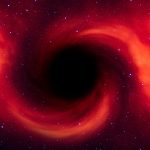Key Takeaways:
- A theory suggests black holes could be dark stars with incredibly dense cores, allowing some light to escape.
- Our current understanding of physics can’t explain infinitely small singularities at the center of black holes.
- Physicists propose “dark stars” with Planck cores as a possible solution, eliminating singularities.
- Dark matter might come from a stream of particles constantly released by dark stars.
- Redshifted photons or light particles could explain dark matter and fast radio bursts (FRBs).
What if black holes, those massive gravitational objects that consume the entire universe, aren’t really black at all? Or even holes, for that matter? According to a recent theory, black holes might actually be dark stars with unusually dense, dense matter at their cores. This may contribute to the explanation of one of the great mysteries of the cosmos: the nature and genesis of dark matter.
Extreme applications of Albert Einstein’s general theory of relativity can be seen in black holes. The term “black hole” refers to locations in the universe where incredibly dense concentrations of matter push the boundaries of space and time, creating an infinitely deep gravitational well from which not even light can escape.
According to scientific theory, a singularity—an infinitely small, dense point—lie at the center of every black hole. At the singularity, gravity is so great that it creates an event horizon around it where gravity’s pull is greater than even the speed of light.
The laws of physics fail at infinitely small singularities. That’s when two seemingly opposing fields of physics—quantum mechanics (describing the super tiny) and general relativity (describing the very large)—come face to face with each other. In order to integrate the two disciplines into a single theory of quantum gravity, researchers plan to investigate the properties of black holes.
The problem? Matter cannot collapse into an infinitely small point, suggesting that the singularity is physically impossible.
Physicists have cleverly dodged this issue by inventing their own singularity-free black holes, which they call “dark stars”. These fantastical structures resemble black holes from the outside, but inside they have a “Planck core,” or incredibly (though not infinitely) dense core of matter compressed to the smallest possible scale. It takes its name from the Planck length, a fundamental unit of measurement that is 100 trillion times smaller than a proton and is on the order of 10^-35 meters.
A dark star could theoretically allow light to escape its strong gravitational pull if it did not have a singularity at its center. Redshift is the name given to the observable phenomenon where any light that managed to escape the black hole would be stretched like a slinky by the gravitational pull of the dark star.
In a paper published on the preprint server arXiv, physicist Igor Nikitin of the Fraunhofer Institute for Scientific Algorithms and Computing in Germany notes that “dark stars behave interestingly in strong gravitational fields.”
The event horizon, which is characteristic of actual black holes, is first removed. Rather, a deep gravitational well forms, where the redshift values reach extraordinarily high values. Because of this, the star appears black to an outside observer, much like a true black hole.
According to Nikitin, this phenomenon may be able to shed light on the true nature of dark matter.
The rotation of stars around galaxies was found to be much faster than expected for the amount of matter visible to astronomers, which led them to make the initial discovery of dark matter. As of right now, we know that dark matter, which is entirely undetectable to humans, makes up about 85% of the universe’s mass. Despite knowing dark matter is out there, however, scientists still don’t really know where it comes from.
Black holes might be a possible source of dark matter if they held Planck cores, as suggested by Nikitin’s research. According to his research, there is a possibility that dark stars constantly release a stream of particles known as dark matter, which could account for the stars’ fast rotation around galaxies.
“One more fascinating possibility is that the dark matter is composed of known particles, placed in an unusual condition,” Nikitin says.
He says the particles could be as basic as photons, or particles of light, that have been redshifted to such wide wavelengths that modern radio telescopes would hardly notice them. Its wavelength, which is 16 times larger than the Sun-Pluto distance and approximately 4 light days, is enormous.
While the energy of these photons would be tiny, their quantity might be sufficient to account for the peculiar movement of stars within their galaxies. According to Nikitin, his theory could also provide an explanation for another unexplained mystery in space: the origin of fast radio bursts (FRBs), which were first identified by astronomers in 2007 but whose nature and origin are still unknown. Nikitin posits that if an asteroid were to collide with a Planck core, a flash of high-energy light waves could be released, and the intense gravitational pull of the dark star would redshift the light, producing an apparent FRB that could be observed on Earth.
Even though dark stars may be able to shed light on two of the greatest mysteries in the universe, Nitkin’s theory would still need to account for a mountain of observational data before it could displace the widely held belief that black holes exist. His theory does, however, show that out-of-the-box thinking can provide creative solutions to seemingly impossible problems.


